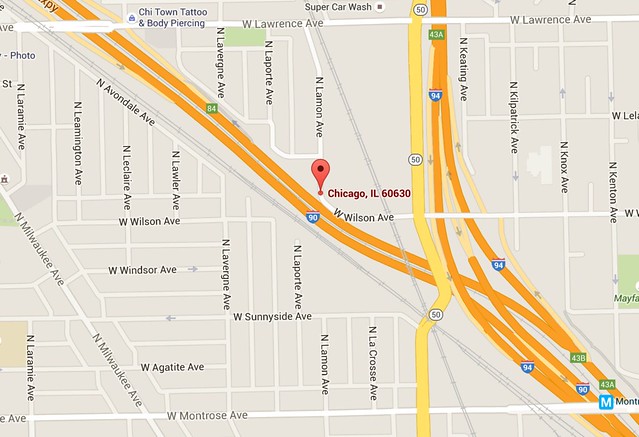Some Streetsblog Chicago commenters have argued that Steven Vance and myself are always in favor of limiting car access in the name of street safety, but that’s not the case. We're still not sure whether a Chicago Department of Transportation street closure project in Jefferson Park was prompted by a speeding and crash problem, as CDOT claims, or if the main motivation was to make room for a digital billboard.
On Monday morning, 45th Ward Alderman John Arena used his car to blockade the intersection of Wilson Avenue and Lamon Avenue, where CDOT crews were tearing up the asphalt in preparation for building cul-de-sacs. Arena says the department did not notify him of the work before it started last weekend, and he’s opposed to the project because he feels its main purpose is to give public space to a private billboard company. The alderman’s stunt resulted in plenty of media coverage, and it was also effective in getting CDOT to the bargaining table – officials met with him that day to negotiate, and agreed to halt the project until a public meeting can be held.
Back in 2013, City Council voted to allow the advertising company J.C. Decaux to install a digital signs at this location by the Kennedy Expressway and many other spots near expressways across the city. Arena, a member of the council’s Progressive Caucus who often opposes Mayor Rahm Emanuel’s initiatives, voted against the deal.
The original proposal was to install the Wilson/Lamon sign on the front lawn of the adjacent Mayfair Pumping Station, but permanently closing the intersection will allow the 90-foot tall sign to be erected in the middle of Wilson. However, in a statement released on Monday before the meeting with Arena, CDOT spokesman Mike Claffey said that the decision to build cul-de-sacs was in response to “a history of excessive speeding on Lamon and Wilson due to cut-through traffic.”:
“These improvements, while addressing traffic safety and improving conditions on the increasingly residential section of Lamon, also accommodate the placement of a digital sign which was approved by City Council in 2013,” Claffey stated. “These changes will address the speeding problem, eliminate crashes from cars that lose control at the curve from Lamon to Wilson, and reduce the number of trucks that strike the low-clearance viaduct on Wilson.”
After meeting with CDOT, Arena told DNAinfo that the department agreed to fill in the hole they dug and temporarily cover it to allow car access. In addition to holding a yet-to-be-scheduled community meeting about the project, CDOT promised to look into alternative locations for the sign and study the potential traffic impacts of the road closure, Arena said. "Special interests like the lobbyists behind the digital billboard industry in Chicago should not control the streets in our communities," he added.
“The Alderman raised additional concerns on traffic congestion in the greater community, which CDOT has agreed to evaluate,” Claffey said in a statement. “There will be a short pause in work as information is compiled and shared.” He did not provide crash statistics for Wilson/Lamon in time for publication – I’ll update the post with this info if it becomes available.
“We haven’t seen any data yet,” 45th Ward chief of staff Owen Brugh told me. “We’ll ask CDOT to present that information at the public meeting, so that the community has the opportunity to understand why CDOT thinks full closure is the only way to make this area safer.” Arena has brought up the idea of speed humps as an alternative to the cul-de-sacs.
Aside from the public space issue, the alderman believes that that cul-de-sac-ing the intersection would create traffic problems, Brugh said. “Lamon and Wilson serves as a relief valve for congestion on Lawrence and provides direct access to on- and off-ramps by the Edens Expressway.” He added that closing the streets would reduce access to a Streets and Sanitation yard on Lamon where dozens of garbage trucks park, and that viaduct crashes seem to be more of a problem on Lawrence than on Wilson.
“The alderman was surprised by the construction – we had no prior notice,” Brugh said. “We’re glad we’re finally going to have the community meeting we should had months ago about this project.”
So, is the street closure really an effort to reduce crashes, or was it mostly an effort to raise revenue for the city via the billboard -- and possibly an intentional poke at one of Emanuel’s least favorite aldermen? The answer isn’t obvious yet, but if CDOT provides data showing a significant amount of crashes at this location, it will certainly strengthen their case. Even if the stats suggest that the street closure is warranted, it's clear that the department should have notified the community, or at least the alderman, before sending out the bulldozers and backhoes.






